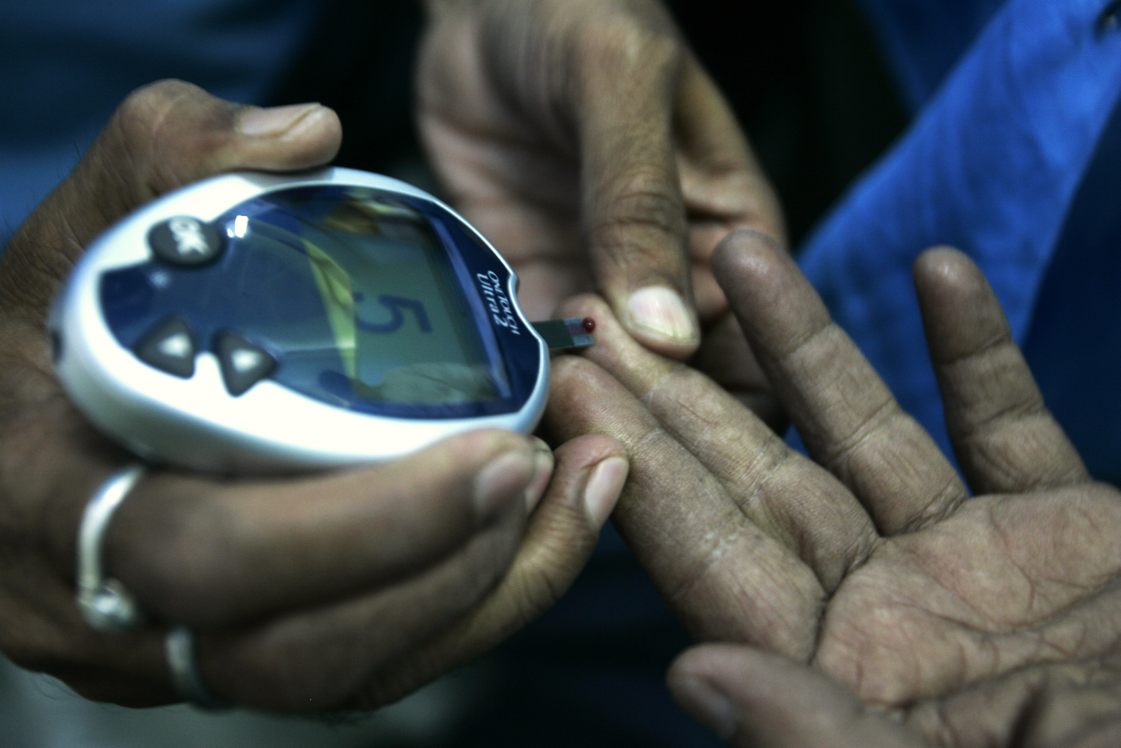Few diagnoses are more frightening to parents than the news that their child has type-1 diabetes. To minimize organ damage and avoid nighttime tragedy, blood glucose must be measured continually. Continuous monitoring of blood glucose is a crucial responsibility, and one that is very difficult for children to do reliably, so it usually falls to parents to ensure it is done properly. For years, frequent measurement of blood glucose by patients themselves required a thin, sharp “finger stick” used to pierce the end of a finger and make it bleed. The resulting blood sample was then touched to the chemically treated end of a small plastic test strip inlaid with a thin gold electric circuit, and the strip was read by a meter to determine the concentration of glucose in the sample. The resulting glucose reading was used to calibrate insulin injections and food consumption to keep blood glucose levels within a healthy range.
The availability of affordable and accurate continuous glucose monitoring (CGM) devices a decade ago allowed type-1 diabetics and their caregivers to measure blood glucose concentrations every few minutes, enabling much more accurate calibration of glucose levels and much more finely tuned injections of insulin and ingestion of food. This system typically relies upon a surgically implanted glucose sensor connected to a transmitter that broadcasts blood glucose measurements to a receiver capable of analyzing and graphically displaying these measurements. By watching the receiver, one can quickly detect blood glucose concentrations likely to stray beyond healthy levels. Until recently, however, the receiver had to be in close proximity to the transmitter to detect glucose readings. For children, this meant a caregiver responsible for monitoring healthy blood sugar levels had to stay near the patient. This curbed the sorts of activities in which children were safely able to participate, interfering with school attendance, team sports or even sleepovers, unless a parent was present with the receiver. This often meant a life of social deprivation for diabetic children.
In 2013, hackers began to disassemble CGM monitors to enhance their capabilities. Success quickly followed these efforts, with the appearance of free smartphone apps that transformed iPhones and Android phones into mobile CGM devices. Finally, children could be away from their worried parents, who could follow their children’s blood glucose level whenever and wherever they wanted. What began as a small, dispersed number of rebel hardware and software engineers soon evolved into a confederation of CGM developers who call themselves Nightscout, a name intended to evoke the very real danger that diabetics face: that of slipping into diabetic coma while asleep each night.
Despite lacking traditional economic incentives such as profit or patent — and without a formal hierarchy, managerial organization or even government approval — open, user and collaborative (OUC) innovation by Nightscout gave society an important medical invention whose benefits to patients were immediate and substantial. Nightscout accomplished this even in the face of hostility by companies and regulatory agencies that saw Nightscout’s “insurgent” mode of unregulated innovation as a threat to the corporate and legal status quo. However, the innovations Nightscout contributed were so valuable that the leading manufacturer of CGM products rapidly incorporated their features into its devices, with surprisingly swift formal regulatory approval. Since this success, many in the Nightscout innovation community have joined efforts to develop an artificial pancreas (which this community calls the “AP”) capable of combining CGM with automated delivery of insulin to help patients better maintain healthy blood glucose levels. These are only two of many examples of successful OUC innovation.
Innovation in the Dark, Steps into the Light
Since the Venetian Republic first created patents in the fifteenth century to reward new inventions, traditional incentives have dominated formal innovation policy. Common policy tools designed to promote new technologies have included intellectual property laws, government funding and lucrative prizes. These have certainly led to some innovation. However, OUC innovation has gone unrecognized for far too long. National economic surveys have revealed that, in such disparate economies as the United States, the United Kingdom, Japan, Finland, Denmark and Canada, OUC innovation dwarfs the research and development expenditures of companies and governmental entities in terms of both time and money. It turns out that citizens, working either alone or collaboratively, are a vital source of innovation.
Why would a person innovate without the prospect of financial reward? After all, classical economics fails to explain how such innovation would satisfy an individual’s utility function. Individuals often have incentives to innovate that originate outside traditional markets: they may innovate to solve their own problems, especially when traditional markets have failed to do so. Once individual innovators have solved their own problems, their personal utility function has largely been satisfied. While some innovators certainly do decide to turn their innovations into commercial products or processes they can sell in the marketplace, the vast majority appear to be content with the personal improvement their innovations have brought to their own welfare. In fact, many OUC innovators prefer to give away the secrets of their innovations rather than commercialize them.
Both OUC innovation and entrepreneurial innovation substantially benefit society by delivering new technologies and greater knowledge. For this reason, innovation policy needs to be rebalanced to ensure that it does not encourage one form of innovation to the detriment or neglect of the other. In practice, this means formally embracing OUC innovation and removing financial, legal and regulatory barriers to its successful flourishing. The citizen innovators of Nightscout delivered substantial and free improvements to the health and well-being of type-1 diabetes patients, despite regulatory hostility and lack of government funding, using an approach that has now been adopted by the AP community. If citizen innovation has already provided substantial benefits to society without formal recognition or assistance, only imagine how much it could contribute to human betterment if it operated in a more consciously benign and encouraging policy milieu. Setting OUC innovation free is a vital policy priority for both citizens and their governments. Tremendous gains in human welfare are possible if innovation is both freely contributed to society by innovators and freed of unnecessary regulatory burdens. Intellectual property incentives and governmental regulation remain important sources and safeguards of innovation, but citizens, corporations and their governments must also learn the value of setting innovation free.
Andrew Torrance is a senior fellow with CIGI’s International Law Research Program. He is also the Earl B. Shurtz Research Professor at the University of Kansas School of Law and has been a visiting scholar in behavioral and policy sciences at the Massachusetts Institute of Technology Sloan School of Management since 2011.



